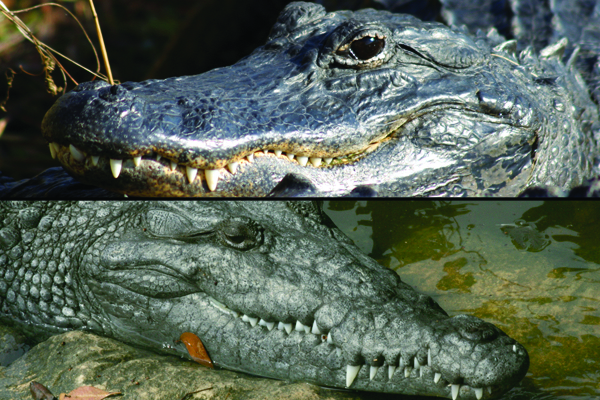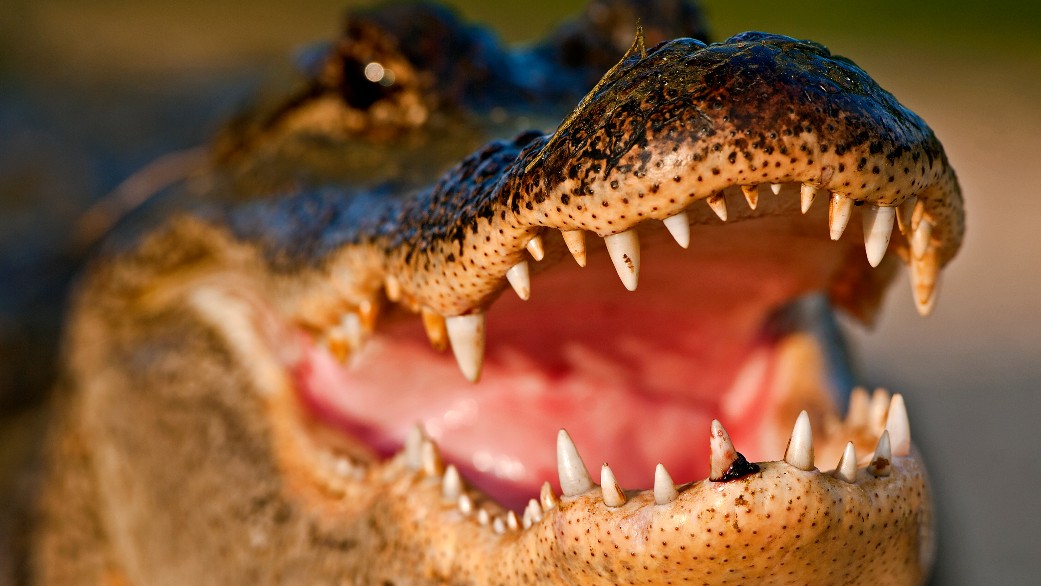
How are alligators and crocodiles different?
How to tell alligators and crocodiles apart

All alligators and crocodiles belong to a taxonomic order called Crocodylia. Crocodylia is then split up into three major families; Alligatoridae (alligators), Crocodylidea (crocodile) and Gavialidae (gharial), according to the journal Pathology of Wildlife and Zoo Animals.
These Crocodylia share a common evolutionary ancestor; however, around 80 million years ago - during the Late Cretaceous period - Alligatoridae and Crocodylidae diverged and continued along their own evolutionary journey, according to the New York Times. Over millions of years of evolution, both crocodiles and alligators have remained relatively similar in their appearance, but there are some surprising differences that are easy to spot.
Related: Mystery of extinct horned crocodile solved after 150 years
Do alligators and crocodiles look different?
At first glance, crocodiles and alligators look quite similar; however on closer inspection, the two have very different snouts. There is one quick-fire way to distinguish a crocodile from an alligator: Look at their jawline. Alligators have an overbite, and so the teeth on the bottom jaw fit into sockets in the top jawline and are concealed. The teeth on the bottom row of a crocodile's jaw, on the other hand, sit on the outside of the mouth and slot into grooves along the top jaw, according to Biology and Evolution of Crocodylians. The shape of their heads is also a key identifier. Alligators have a U-spaced rounded snout that is wide and short, whereas crocodiles have a longer pointed, V-shaped snout. There are some exceptions to the rule, such as the mugger crocodile (Crocodylus palustris), which has a rounded snout reminiscent of an alligator, according to San Diego Zoo Wildlife Alliance.
Both of these reptiles have tiny black specks called integumentary sense organs (ISOs) on their heads. These sensory organs allow the predators to detect pressure changes in the water caused by potential prey. ISOs can be found solely on the head and around the mouth of alligators; crocodiles have ISOs on almost every scale on their body, according to the Journal of Experimental Biology.

Differences between the two reptiles are also much more than skin deep. In a study published in 2018 in the journal Royal Society Open Science, researchers found that, compared with crocodiles, the forelimbs of alligators have a shorter humerus bone and hindlimbs have shorter femurs.
Where do crocodiles and alligators live?
One major difference between alligators and crocodiles is where they live. Crocodiles have lingual salt glands - on their tongues - which allow them to expel excess salt from their bodies, according to a study published in the Journal of Comparative Physiology. This ability allows them to live in salty marine environments, such as Australia's saltwater crocodiles (Crocodylus porosus) - which reside throughout mangroves, swamps and deltas. Although alligators have the same salt gland, that gland is not very effective and limits the alligator's tolerance for salt water. Therefore, alligators stick to freshwater habitats, such as lakes and marshes.
This difference in salt tolerances could also explain differences in their global distribution. Crocodile species can be found across the Americas, Africa, Asia and Australia, whereas alligators are predominantly found in North and South America, according to National Geographic.
Related: Alligators can regrow their tails, surprising scientists
Additional resources
- For more information about the evolution of crocodiles and alligators check out: The Rise of Reptiles: 320 Million Years of Evolution
- Herpetology: An Introductory Biology of Amphibians and Reptiles
- Discover the population status for crocodiles and alligators at the International Union for Conservation of Nature (IUCN) Red List
Sign up for the Live Science daily newsletter now
Get the world’s most fascinating discoveries delivered straight to your inbox.

Scott is a staff writer for How It Works magazine and has previously written for other science and knowledge outlets, including BBC Wildlife magazine, World of Animals magazine, Space.com and All About History magazine. Scott has a masters in science and environmental journalism and a bachelor's degree in conservation biology degree from the University of Lincoln in the U.K. During his academic and professional career, Scott has participated in several animal conservation projects, including English bird surveys, wolf monitoring in Germany and leopard tracking in South Africa.










